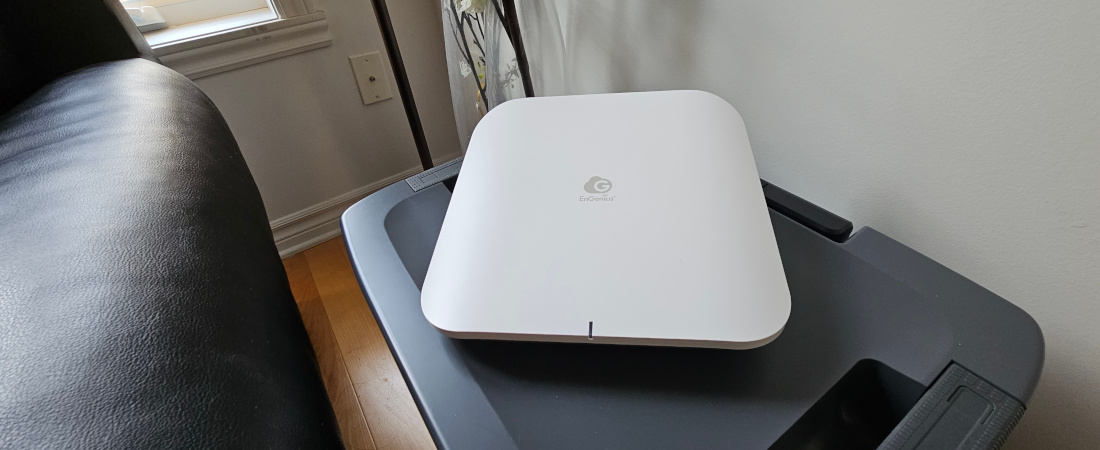TechRadar Verdict
The EnGenius ECW536 Wi-Fi 7 access point improves transfer rates by up to five times compared to Wi-Fi 6. The antenna and onboard amplifier gains are enough for a small office setting, providing a throughput of 300 Mbps or more at a 10-meter range.
Pros
- +
Fast aggregate 18.7Gbps
- +
Good antenna and amplifier gains
- +
Dual 10G ports
Cons
- -
High price
Why you can trust TechRadar
EnGenius’ ECW536 brings Wi-Fi 7 to the office with a wireless access point offering a maximum aggregate throughput of 18.7Gbps.
Model: EnGenius ECW536
CPU: Quad-core Qualcomm 1220 CPU
RAM: 2GB
Storage: 256MB NAND
Radios: One 4x4 for 6GHz Wi-Fi 7 / 6e, One 4x4 for 5GHz Wi-Fi 6, One 4x4 for 2.4GHz
Wireless throughput: Theoretical 18.7Gbps
Ports: 10Gb Ethernet with PoE, 10Gb Ethernet
Weight: 1.3 kg
Dimensions: 23 cm x 23 cm x 37 mm
Power Consumption: 15W with one client connected, 38W maximum consumption
MSRP: $1199
The dual 10Gbps Ethernet ports turn the unit into a 10G switch. A large aluminum backplate acts as a heatsink, dissipating up to 35W. The only accessories provided are a mounting bracket and screws. The unit thus requires a PoE LAN or an external 12V DC adapter to work correctly.
The access point integrates three radio modules, providing Wi-Fi 7 connectivity and Wi-Fi 6, 5, and 2.4GHz backward compatibility. Antenna gains are between 5dBi and 6dBi, similar to competitive APs, while onboard radio amplifiers provide an average boost of 5dBm. All this means that the ECW536 covers a surface of 100 meters square with a throughput of 300 Mbps or more.
EnGenius offers a range of access points that can work in a mesh. That is particularly interesting if one wants to boost the network throughput while extending the range simultaneously. The ECW536 retails for $1199 but is on sale for $499. The smaller version with a 2x2 radio configuration costs $456 while not on sale.
EnGenius ECW536: Design
The EnGenius access point ships with one accessory box containing the mounting kit. Once installed, the unit locks to the base by rotating it. The white plastic enclosure has a metal backplate that doubles as a heat dissipator. Two Ethernet connectors and a 12V DC socket at the back connect to the network. A small hole is also present to reset the device using a paper clip. The case gets warm after some time, eventually reaching 50 degrees Celcius. The access point measures 23 cm x 23 cm x 37 mm and weighs 1.3kg.
The ECW536 uses a Qualcomm Pro 1220 multichip design. The processor is a fast quad-core ARM A73 CPU, which can support up to eight SSIDs on the 2.4GHz and 5/6GHz bands. There are also built-in VLAN tagging and a QoS for increased bandwidth management. Complementing the CPU are 2GB of RAM, 256MB of Flash, and two 10G Ethernet interfaces, which also support 5G, 2.5G, 1G, and 10/100Mbps.
Three Wi-Fi radios each serve a specific frequency while supporting four spatial streams, the twelve paths aggregating for a throughput of 18Gbps. Maximum transmit gains, which depend on country location, vary between 24dBm and 25dBm, while antenna gains vary between 5dBi and 6dBi.
The ECW536 access point consumes 13W without connected clients, which increases to 20W when one user actively uses the AP. A single multicolor LED gives feedback on the unit’s operation and is a departure from the past Wi-Fi 6 version, which had four LEDs. The AP is ready when the LED is green. Blue indicates that there is at least one connected client. The user can adjust the LED’s brightness through the mobile app.

EnGenius ECW536: In Use
Setting up the access point can be done entirely through the mobile app, which is available for Android and iOS platforms. The user needs an account to begin the installation. The AP and other EnGenius units can be added using a QR code on the back of each unit.
To fully utilize the Wi-Fi7 bandwidth, we strongly recommend connecting the AP to a 10Gb Ethernet LAN supporting PoE with at least 50W of available power. The ECW536 LED will blink orange if the PoE switch cannot provide sufficient power. Thus, the optional power socket becomes handy with an external 12V supply and completes the setup.
The mobile application offers features similar to those available on the cloud portal. The convenience of controlling access to the Wi-Fi network at one’s fingertips is very enticing. The user can also see what device consumes the most bandwidth at any time. However, the most helpful thing remains the ability to check the access point’s health from any place with Internet access.
The ECW536 offers mesh capability to increase signal reach; the AP can connect to other ECW536 units or previous-generation models such as ECS230S. There are obvious reasons to use one against the other. In a Wi-Fi 6 infrastructure, the ECW536 will mesh using one of its four 160MHz backhaul channels, providing a maximum of 1.4Gbps as throughput. On the other hand, using several ECW536 yields the best range and throughput since the backhaul is now over Wi-Fi 7 at 2.9Gbps.

EnGenius ECW536: The competition
Upgrading from something other than Wi-Fi 6 to Wi-Fi 7 should be a sound investment for the next few years, mainly because of the higher throughput offered by the denser 4096 QAM encoding. Still, fierce competition in consumer-level routers continues to drive prices down. The ECW536 comes with more technical support and an overall better performance when compared to consumer products.
Based on the same Qualcomm technology, the Zyxel WBE660S provides a similar throughput and range compared to the ECW536, while the Zyxel AP costs less than the EnGenius. A second 10G Ethernet port on the ECW536 turns it into a 10G switch, something lacking on the WBE660S. The ECW536 is also more compact and lighter, making installation a breeze compared to the WBE660S. Finally, the EnGenius AP consumes less energy than Zyxel’s access point, resulting in a device that will last longer while costing less electricity.
EnGenius ECW536: Final verdict
Thanks to the new Wi-Fi 7 standard, the EnGenius ECW536 takes wireless networks to the next level by adding more range and bandwidth. The range should be as good as previous 5GHz access points. The increase in bandwidth results from using a better encoding algorithm, quadrupling the throughput compared to Wi-Fi 6. These gains come with higher power dissipation and a more expensive unit. A 10G LAN infrastructure supporting PoE is required to use the AP to its fullest potential.
EnGenius offers a 5-year warranty on the ECW536 and customer support via online chat, phone, or email. The AP has cloud access, allowing network inspection and problem resolution remotely.
Buy the ECW536 if:
You are starting a new network that requires lots of bandwidth and range.
Dont buy the ECW536 if:
You already have a Wi-Fi 6 AP fleet from another manufacturer
My interest has been piqued by everything electronic since a young age, with a penchant for the dark art of tearing things apart. My daily duty is to marry software and hardware modules and I have to admit that this is much harder than cooking. When I’m not busy at work, I’m on the lookout for the latest and greatest hack! I am passionate about portable power generators (or power stations) as well as maker products such as the Raspberry Pi and any similar SBC (single board computers)

